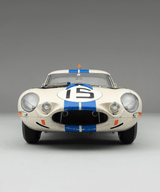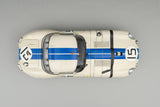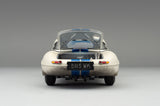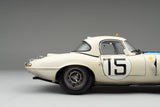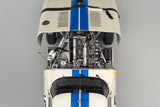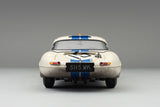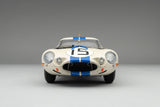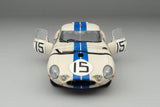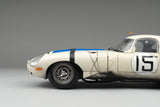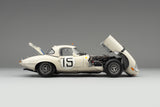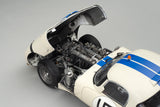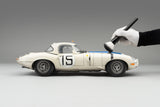The Jaguar E-type was never meant to race. Its sweeping bodywork certainly took inspiration from the sleek aerodynamic profiles of the racing C-types and D-types, and its monocoque chassis and disc brakes had been race-honed at Le Mans, but the E-type's innovative independent rear suspension was designed to be B-road friendly, while the 3.8-litre straight-six XK engine was tuned to be easier to drive at low speed. As demand for E-types outstripped production capacity at the Jaguar Brown's Lane factory, there was little need for the E-type to go racing. Indeed, road car production took priority over a return to motorsport.
This fine 1:8 scale model is of the #15 Jaguar Lightweight E-Type (XKE) as driven at the 1963 edition of the 24 Hours of Le Mans by American duo Briggs Cunningham and Bob Grossman on the 15th and 16th of June 1963. Cunningham, who had raced Jaguar's E2A prototype in the 1960 race, had given the standard E-type its Le Mans debut in 1962, earning fourth place and class win alongside Roy Salvadori, ahead of a second E-type driven by Peter Sargent and Peter Lumsden. The next year, Cunningham was back, this time armed with three Lightweights and official support from the factory. Cunningham drove with Bob Grossman with his other regular drivers Walt Hansgen and Salvadori paired with Augie Pabst and Paul Richards in the #14 and #16 cars respectively. The #14 car withdrew after an hour, suffering from gearbox issues, whilst the #16 was involved in a terrible crash after six hours, which unfortunately killed Brazilian driver Christian ‘Bino’ Heins. Fortunately for Salvadori, he had been unable to do up his full harness and was thrown out the rear window as the car burst into flames, suffering serious injury but surviving. The #15 of Cunningham and Grossman persevered, moving steadily into the top-10 through the night. However, on Sunday morning the brake pedal snapped as Grossman came to the end of the Mulsanne straight. The car slammed through three rows of haybales, scattering spectators, but he was able to get the car back to the pits. Stealing parts from the #14 car that remained intact, they lost two hours but got back into the race. Grossman and Cunningham crossed the finish line in ninth position overall and second in class. One can only speculate how well the car might have finished were it not for its brake pedal failure.













